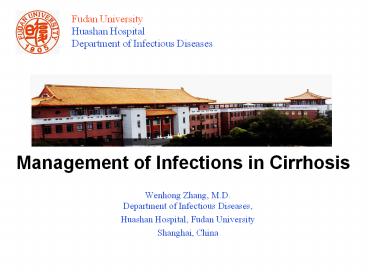Management of Infections in Cirrhosis - PowerPoint PPT Presentation
1 / 31
Title:
Management of Infections in Cirrhosis
Description:
Fudan University Huashan Hospital Department of Infectious Diseases Management of Infections in Cirrhosis Wenhong Zhang, M.D. Department of Infectious Diseases, – PowerPoint PPT presentation
Number of Views:273
Avg rating:3.0/5.0
Title: Management of Infections in Cirrhosis
1
Management of Infections in Cirrhosis
Fudan University Huashan Hospital Department of
Infectious Diseases
- Wenhong Zhang, M.D. Department of Infectious
Diseases, - Huashan Hospital, Fudan University
- Shanghai, China
2
Liver cirrhosis and Infections
Severity of infections
- Liver cirrhosis is associated with defects in the
immune system, which increase the risk and
severity of infections.
Rekha Cheruvattath. J Clin Gastroenterol
200741403411)
3
Risk factors of infections in cirrhosis--Intestin
al mucosal barrier and bacterial translocation
Reiner Wiest and Guadalupe Garcia-Tsao.
HEPATOLOGY, Vol. 41, No. 3, 2005
4
Risk factors of infections in cirrhosis --
DC-mediated transport of bacteria
Reiner Wiest and Guadalupe Garcia-Tsao.
HEPATOLOGY, Vol. 41, No. 3, 2005
5
Risk factors of infections in cirrhosis --
Bacterial translocation
Cirera I, et al. Journal of Hepatology 34 (2001)
3237
6
Risk factors of infections in cirrhosis --
invasive procedures
Reiner Wiest and Guadalupe Garcia-Tsao.
HEPATOLOGY, Vol. 41, No. 3, 2005
7
Most common infections in cirrhosis
- spontaneous bacterial peritonitis (SBP) (25)
- urinary tract infection (20),
- pneumonia (15) ,
- bacteremia (12)
- others
8
Most common causative organisms
- Most common organisms isolated
- Gramnegative bacteria (GNB)
- E. Coli
- Klesiella
- Enterobacteriaceae species
- Gram-positive cocci (GPC)
- Pneumonia (mainly Streptococcus pneumoniae)
- Bacteremia associated with invasive procedures
(mainly staphylococci).
9
Increasing causative organisms --Fungal infection
- Candida
- Cryptococcus
- Aspergillus
- Coccidiodomycosis
10
Management of Infections
- SBP and other bacterial infections
- Fungal infections
11
Treatment of SBP regimens and indications
AASLD PRACTICE GUIDELINE. Management of Adult
Patients with Ascites Due to Cirrhosis An
Update. HEPATOLOGY, Vol. 49, No. 6, 2009
12
Antibacterial regimens for SBP
EASL clinical practice guidelines on the
management of ascites, spontaneous bacterial
peritonitis, and hepatorenal syndrome in
cirrhosis. Journal of Hepatology 2010 vol. 53
,397417
13
AASLD PRACTICE GUIDELINE. Management of Adult
Patients with Ascites Due to Cirrhosis An
Update. HEPATOLOGY, Vol. 49, No. 6, 2009
14
Prevention of SBP regimens
AASLD PRACTICE GUIDELINE. Management of Adult
Patients with Ascites Due to Cirrhosis An
Update. HEPATOLOGY, Vol. 49, No. 6, 2009
15
Prevention of SBP regimens and duration
EASL clinical practice guidelines on the
management of ascites, spontaneous bacterial
peritonitis, and hepatorenal syndrome in
cirrhosis. Journal of Hepatology 2010 vol. 53
,397417
16
Spectrum of drug resistance to 3rd generation of
cephalosporin
Xavier Ariza et al. Journal of Hepatology 2012
vol. 56,825832
17
Drug resistance to 3rd generation of cephalosporin
Xavier Ariza et al. Journal of Hepatology 2012
vol. 56,825832
18
Drug resistance in enterobacteriaceae
19
(No Transcript)
20
Enterococci infection
21
Antibiotics against GPC
22
Algorithm for the therapeutic management of
infections when MRSA risk factors are present
Niederman MS. Journal of Infection (2009) 59(S1)
S25 S31
23
Pneumonia
- Community-acquired pneumonia still remains the
most common type with Streptococcus pneumoniae - In alcoholic cirrhosis, infection with anaerobes,
Hemophilus influenzae, and K.pneumoniae are of
particular concern. - Hospital-acquired pneumonia is predominantly
caused by gram-negative bacilli and
staphylococci. - Third generation cephalosporins are generally
recommended, with nosocomial pneumonia needing
J Clin Gastroenterol 200741403411)
24
Microorganisms Causing Pneumonia-- by Time After
OLT
Aduen JF, Hellinger WC, Kramer DJ, et al. Mayo
Clin Proc. 200580(10)1303-1306
25
Empiric Therapy for for MDR Pathogens and all
Disease Severity
- Potential Pathogens
- Pathogens listed in previous slide
- MDR pathogens
- P aeruginosa
- K pneumoniae (ESBL)
- Acinetobacter spp
- MRSA
- L pneumophila
Combination Therapy Antipseudomonal
cephalosporin or Antipseudomonal
carbepenem or ß-lactam/ß-lactamase
inhibitor
Antipseudomonal fluoroquinolone
or Aminoglycoside (AMG)
Linezolid or
vancomycin FQs
ATS/IDSA Guidelines. AJ RCCM. 2005171388-416.
26
Management of Fungal infections(1)
Am J Respir Crit Care Med Vol 183. pp 96128, 2011
27
Management of Fungal infections(2)
Am J Respir Crit Care Med Vol 183. pp 96128, 2011
28
Management of Fungal infections(3)
Am J Respir Crit Care Med Vol 183. pp 96128, 2011
29
Anti-fungal treatment considering hepatic
toxicities
Infection 2010 38 311
30
Conclusions
- Infections in cirrhosis are a common cause of
morbidity and mortality - Abnormalities in cellular and humoral immunity
and the increasing use of invasive procedures
predispose these patients to a variety of
infections. - Clinicians should have a low index of suspicion
as prompt detection and the use of appropriate
treatment can improve survival in these patients.
31
Thank you!































